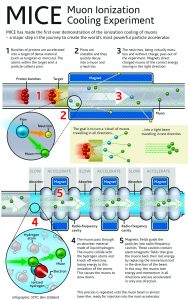
The Muon Ionization Cooling Experiment, pictured here at Rutherford Appleton Laboratory in the United Kingdom, has for the first time successfully cooled a beam of muons, essentially focusing a diffuse cloud of muon particles. The collaborators used powerful superconducting magnetic lenses and specially designed energy absorbers to achieve this milestone. Photo: Rutherford Appleton Laboratory/UK Science and Technology Facilities Council
For the first time, scientists have observed muon ionization cooling — a major step towards the realization of a potential muon collider. If built, a future muon collider could provide 10 times the discovery reach of CERN’s Large Hadron Collider even after its substantial upgrade.
Since the 1930s, accelerators have been used to make ever more energetic proton, electron and ion beams. These beams have been used in practically every scientific field, from colliding particles in the LHC to measuring the chemical structure of drugs, treating cancer and the manufacture of the ubiquitous silicon microchip.
Now, the international Muon Ionization Cooling Experiment, or MICE, collaboration has made a major step forward in the quest to create an accelerator for an entirely different sort of particle, the muon, a heavy and relatively short-lived relative of the electron. A muon accelerator could become a successor to the LHC, providing a 10-fold increase in energy for the creation of new particles.
One measure of the discovery potential of an accelerator is luminosity, which quantifies how many collisions happen per second. For a given number of particles in the colliding beams, smaller beams yield higher luminosities and thus more collisions. Having more collisions increases the likelihood to discover something new about the fundamental constituents of our universe.
Until now, the question has been whether it’s possible to “squeeze” a beam of muons sufficiently to achieve the luminosity needed to study new physics. The new research, published in Nature on Feb. 5, shows that it is possible. The results of the experiment, carried out using the MICE muon beamline at the UK Science and Technology Facilities Council’s Rutherford Appleton Laboratory, clearly show that ionization cooling works and can be used to channel muons into a tiny volume. Fermilab staff played a major role in building and carrying out the experiment.
Muons have many uses: They can be used to study the atomic structure of materials, as a catalyst for fusion, and to see through really dense materials that X-rays can’t penetrate. The MICE team hopes that their cooling technique can help produce high-quality muon beams for those applications as well.
Muons, which have about 200 times the mass of an electron, are copiously produced by smashing an intense beam of protons into a target whose material can be a dense liquid such as mercury or a light solid such as carbon. Because their production mechanism involves the decay of particles produced by the protons, these muons form a diffuse cloud. This cloud of muons can be separated from the remaining debris and directed through a series of magnetic lenses. When two such diffuse beams cross each other, the chance of collisions is very small.
To make the cloud less diffuse, scientists employ a process called beam cooling. This involves getting the muons closer together and moving in the same direction. Magnetic lenses can focus the muons either closer together or make them move in the same direction, but not both at the same time.
A major obstacle to doing this is that the muon’s lifetime at rest is about two millionths of a second (2.2 microseconds), and previous methods developed to cool beams take hours to achieve an effect.
The MICE collaboration demonstrated for the first time a method to tackle this unique challenge: cooling the muons by putting them through specially designed energy absorbers made of materials such as lithium hydride or liquid hydrogen. This was done while the beam was very tightly focused by powerful superconducting magnetic lenses.
After this cooling process is repeated many times, the muons can be accelerated to high energy (which increases their lifetime in the laboratory due to special relativity), injected into a particle storage ring, and aimed at an antimuon beam moving in the opposite direction to produce collisions. Alternatively, the cold muons can be slowed down so that their decay products can be studied. Or a single muon beam can be stored in a racetrack-shaped ring and allowed to decay, producing uniquely powerful neutrino beams that can provide new physics opportunities for future neutrino experiments.
The MICE collaboration, led by Professor Ken Long of Imperial College London, benefited from the support of the UK Science and Technology Facilities Council, Fermilab, the U.S. Department of Energy’s Office of Science and the National Science Foundation, and institutes across the world. It was the enthusiasm, dedication and hard work of the international collaboration and the outstanding support of participating institutes across the world that made this game-changing breakthrough possible.
Alan Bross is a Fermilab scientist, and Dan Kaplan is a professor at the Illinois Institute of Technology. Both are members of the MICE collaboration.
The UK Science and Technology Facilities Council announced this result in a press release on Feb. 5.
About the Science and Technology Facilities Council
The Science and Technology Facilities Council is part of UK Research and Innovation – the UK body which works in partnership with universities, research organizations, businesses, charities and government to create the best possible environment for research and innovation to flourish. STFC funds and supports research in particle and nuclear physics, astronomy, gravitational research and astrophysics, and space science and also operates a network of five national laboratories as well as supporting UK research at a number of international research facilities including CERN, Fermilab and the ESO telescopes in Chile. STFC is keeping the UK at the forefront of international science and has a broad science portfolio and works with the academic and industrial communities to share its expertise.

